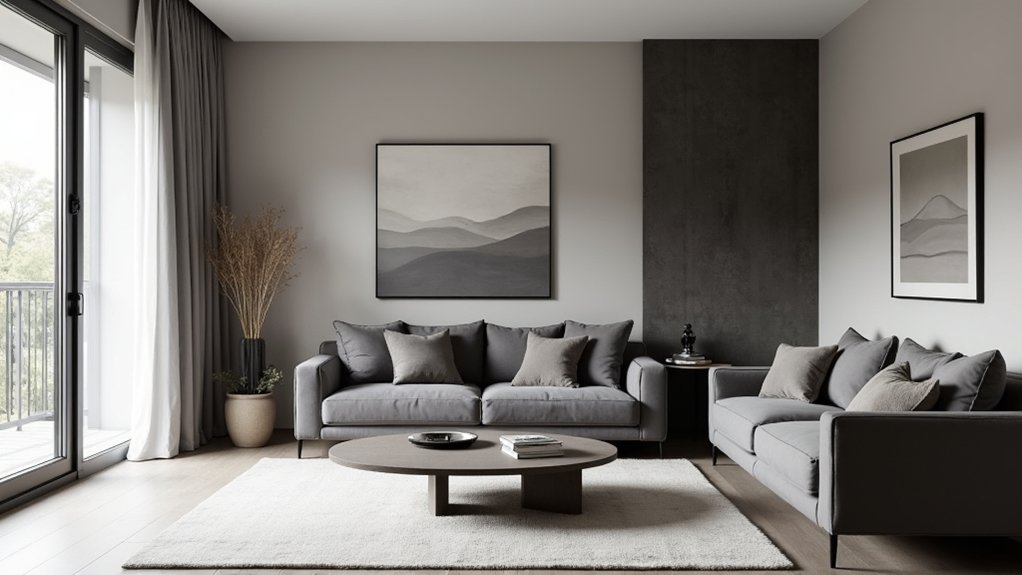
14 Living Room Grey Wall Ideas That Set a Calm Mood
Grey living room walls create a serene, contemporary foundation layered with tonal depth. Expert designers recommend mixing various grey shades, pairing with plush textiles, and integrating earthy accents in wood and leather. Warm ambient lighting offsets cool undertones, while greenery and organic materials enhance tranquility. Strategic use of statement art, black contrast, and textured throws establishes sophisticated focal points. For those seeking additional creative combinations and layout inspiration, this curated collection provides an inviting spectrum of calming grey room possibilities.
Key Takeaways
- Layer various shades of grey on walls, furnishings, and accents to create depth and maintain a serene, cohesive atmosphere.
- Pair grey walls with warm, natural materials like wood, stone, and greenery to add texture and soften the space.
- Incorporate plush textiles—such as velvet pillows and shaggy rugs—for comfort and a cozy, inviting vibe.
- Use warm ambient lighting and dimmers to counterbalance cool grey tones and set a relaxing mood.
- Highlight architectural features with contrasting grey hues or black accents for visual interest without disrupting the calm setting.
Layer Different Shades of Grey for Depth
A nuanced approach to grey wall design leverages the interplay of multiple shades, transforming a living room from monotonous to multidimensional. Contemporary interiors benefit when designers layer different shades of grey—such as pairing light grey walls with medium grey furnishings and dark grey accents—resulting in enhanced depth and visual interest. Careful selection of grey tones with unified undertones cultivates a sophisticated atmosphere, ensuring visual cohesion rather than flatness. Employing the 60-30-10 rule—allocating primary, secondary, and accent hues—enables a balanced, trend-forward palette. Variation in grey intensity also interacts harmoniously with natural light, adjusting the room’s mood and spatial perception. Ultimately, layering greys not only introduces dimension but also establishes a cozy, inviting environment that feels grounded yet airy within the living space. Incorporating geometric shapes and patterns further enhances the modern appeal and design cohesion.
Incorporate Plush Textiles for Comfort

Though grey walls set a refined foundation, the introduction of plush textiles such as velvet or chenille seating immediately improves comfort and visual richness within the living room.
Expertly layered soft furnishings—including cozy wool throws and faux fur pillows—promote a cozy vibe while adding inviting layers of texture that counterbalance the cool neutrality of grey.
For tactile depth and visual interest, a shaggy rug in a complementary shade of grey provides underfoot comfort and prevents the space from appearing flat.
Incorporating natural materials like wood and stone can further enhance the cozy ambiance, providing warmth and an organic touch that complements the grey walls.
This thoughtful interplay of plush textiles and layered texture not only raises the ambiance but also aligns with current design trends that prioritize an inviting atmosphere.
Strategic textural contrasts within soft furnishings guarantee the room feels dynamic and sophisticated, transforming grey walls into a backdrop for modern comfort.
Pair Grey Walls With Earthy Accents
While grey walls establish a sleek and contemporary backdrop, the strategic introduction of earthy accents—such as tan leather sofas and reclaimed wood furniture—injects essential warmth and tactile depth into the living room.
This design approach leverages the neutral canvas of grey walls, allowing natural materials and organic hues to take center stage. Earthy accents not only diffuse the coolness of grey but also reflect a trend-forward emphasis on biophilic design and layered textures. Consider layering different textures like velvet, suede, leather, and wool to enhance visual interest and create a multi-dimensional space.
Consider these expert recommendations:
- Tan leather seating for subtle warmth and luxe appeal
- Reclaimed wood tables to introduce organic structure
- Terracotta vases for rustic, artisanal texture
- Woven baskets to enhance coziness and visual intrigue
- Earth-toned artwork for balanced, harmonious focal points
This synthesis creates a sophisticated, cozy atmosphere imbued with timeless elegance.
Balance With Warm Ambient Lighting
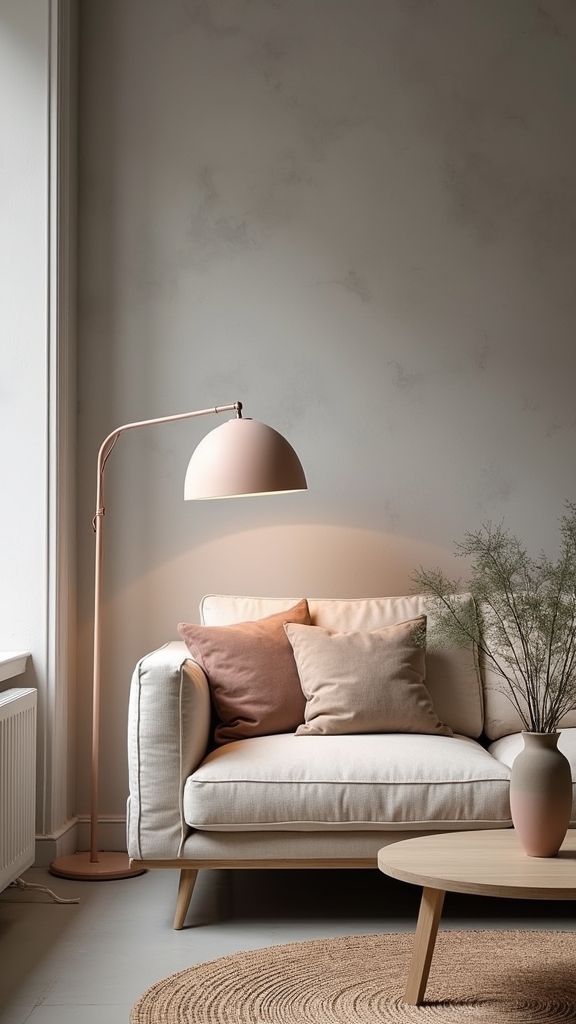
Strategic use of table and floor lamps with warm bulbs introduces a layer of coziness that offsets the inherent coolness of grey walls. Expertly positioned lighting not only enhances comfort but also accentuates textural elements such as tactile fabrics or architectural details. Current design trends favor ambient lighting solutions that allow for both visual warmth and dynamic interplay of light and shadow within the living space. Incorporating soft ambient lighting can further soften shadows and create a warm glow, enhancing comfort and relaxation.
Enhance Coziness With Lamps
A thoughtfully layered lighting scheme enhances the ambiance of a grey-walled living room, transforming what could feel cool or austere into a space of warmth and invitation.
Expert designers recommend integrating lamps to balance the environment, utilizing ambient lighting and warm-toned bulbs to cultivate a cozy atmosphere. The strategic use of layered lighting not only softens the inherent coolness of grey but also delivers customizable ambiance through dimmers and positioning.
To maximize visual interest and comfort, consider these expert approaches:
- Select table and floor lamps with warm-toned bulbs for inviting illumination
- Employ dimmers for adaptable, mood-driven lighting scenarios
- Arrange lamps to accentuate architectural features or curated artwork
- Layer multiple light sources for depth and tactile warmth
- Choose luminaire designs that enhance both style and ambiance
This approach guarantees a sophisticated, trend-forward living space.
Highlight Textures With Lighting
Building on the inviting ambiance created by layered lamps, designers often emphasize the importance of warm ambient lighting to showcase the nuanced textures found within grey-walled living rooms.
Employing layered lighting—combining overhead fixtures, sconces, and table lamps—enables the strategic illumination of textured surfaces, such as exposed stone or upholstered panels.
Warm light tones are especially effective, as they counterbalance the inherent coolness of grey, enhancing the space’s comfort and visual interest.
Incorporating adjustable ambiance through dimmable lights offers flexibility, allowing the mood to shift seamlessly from lively gatherings to tranquil evenings.
This approach not only accentuates the depth and dimension of grey walls but also aligns with current trends that favor tactile richness and a tailored, experiential living room environment.
Add Greenery for a Tranquil Touch
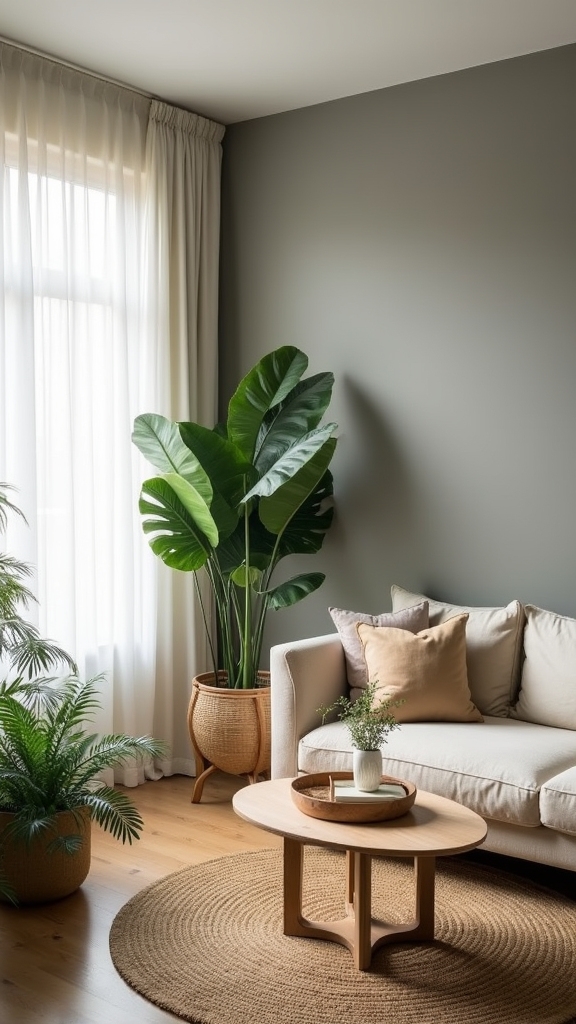
Strategic integration of lush plant varieties—such as ferns, snake plants, and peace lilies—provides dynamic contrast and visual freshness within grey-walled living rooms. Natural materials like wood planters or textured ceramics are on-trend choices to amplify organic warmth and tactile interest. Pairing carefully curated greenery with sophisticated grey palettes results in a balanced, tranquil environment that resonates with contemporary biophilic design principles. Consider incorporating Monstera Deliciosa for its iconic split leaves and touch of tropical elegance, enhancing the serene atmosphere of your living room.
Choose Complementary Plant Varieties
When incorporating greenery into a grey-walled living room, selecting complementary plant varieties is essential for curating a tranquil and visually compelling atmosphere.
The interplay between plants and grey walls introduces organic vibrancy while maintaining a sophisticated, calming atmosphere. To achieve maximum visual interest, it is important to utilize an expert mix of foliage characteristics and container finishes.
Thoughtful selection enhances not only color contrast but also the overall harmony of the space. Consider integrating the following strategies:
- Opt for snake plants, peace lilies, or pothos to introduce lush green tones against grey walls.
- Select plants with varied heights and leaf structures for dynamic layering.
- Use pots in earthy tones to add warmth and cohesion.
- Group plants in clusters or suspended arrangements for a curated look.
- Rotate in seasonal plants to perpetuate a fresh, inviting ambiance.
Highlight With Natural Materials
Incorporating greenery into a grey-walled living room gains further impact when paired with natural materials, a hallmark of contemporary interior design. The juxtaposition of lush foliage against cool grey walls is enhanced by tactile elements such as wood, stone, and woven fibers.
These natural materials introduce warmth and texture, counterbalancing the inherent coolness of grey and fostering a space conducive to relaxation. Earthy accents—such as terracotta planters, jute rugs, or rattan baskets—contribute to a tranquil, grounded ambiance.
This interplay of greenery and organic elements cultivates a balanced aesthetic, where visual serenity prevails. Strategic placement near large windows allows abundant natural light to animate both plant life and raw materials, reinforcing the connection to nature and setting an inviting, soothing tone throughout the living room.
Pair Greenery With Greys
While the restrained elegance of grey walls anchors a living room in modern sophistication, the deliberate introduction of greenery serves as a dynamic counterpoint that enlivens the palette and infuses the space with tranquility.
The interplay between cool-toned grey walls and the organic vibrancy of plants cultivates a tranquil atmosphere, simultaneously promoting visual interest and well-being.
To maximize the calming effect and design cohesion, experts recommend:
- Layering various plant species, such as ferns, snake plants, or pothos, for diverse texture
- Positioning greenery to soften architectural lines and break up monochrome expanses
- Incorporating wood furniture and natural fibers for a harmonious, biophilic synergy
- Rotating seasonal plants—flowering in spring, foliage-rich in autumn—for evolving freshness
- Utilizing sculptural planters to punctuate the living room’s aesthetic with intentional artistry
This approach redefines the modern grey living room, elevating serenity.
Choose Greige for a Softer Neutral Look

A refined alternative to classic grey, greige—a nuanced blend of grey and beige—has emerged as a leading choice for those seeking a softer, more adaptable neutral in contemporary living room design.
Greige’s subtle warm undertones counteract the coolness of standard greys, cultivating an inviting atmosphere ideal for relaxation. This hue excels in north-facing rooms, where its warmth counterbalances cool natural light, ensuring the space remains welcoming.
Greige’s versatility allows seamless integration with earthy tones and natural materials, enhancing organic design elements and fostering a cohesive interior palette.
As a sophisticated backdrop, greige enables vibrant accent pieces to visually resonate without dominating the environment. Its understated elegance and adaptability make greige a trend-forward solution for a softer neutral look in living spaces.
Highlight Architectural Features With Grey
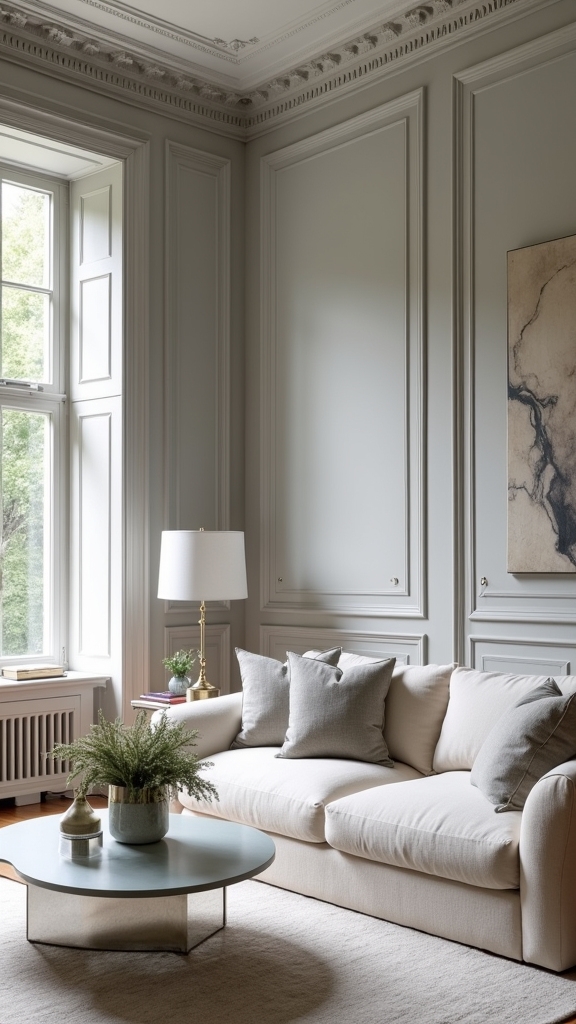
When architectural details are accentuated with grey tones, the living room’s structural artistry is enhanced, imparting a sense of cohesion and refinement. By curating specific paint shades, designers can guarantee that moldings, beams, and built-in shelves become purposeful focal points, not mere background elements. Grey walls serve as a sophisticated neutral backdrop, amplifying the craftsmanship of these features while maintaining a calm atmosphere. The interplay of varying grey hues introduces depth, resulting in a layered, visually dynamic environment. To further highlight architectural details, strategic contrast in trim and accents remains on-trend, guaranteeing crisp definition. Employ deeper grey paint shade for archways to create visual depth. Use lighter grey walls as a neutral backdrop for intricate moldings. Highlight beams with medium greys for architectural emphasis. Integrate contrasting trims to define features. Layer multiple grey tones for a nuanced, contemporary effect. Incorporating natural elements like wood and plants can soften the monochrome palette, adding warmth and texture to the living space.
Complement Grey Walls With Natural Wood

Integrating natural wood accents alongside grey walls introduces essential warmth, counterbalancing the inherent coolness of the palette. This interplay of organic textures and nuanced tones not only enhances visual interest but also aligns with contemporary trends favoring tactile contrast. The result is a sophisticated yet inviting space, where modernity is softened through the strategic use of wood’s natural grain and color. Incorporating luxurious fabrics and material selection like velvet and silk alongside the wood can further elevate the elegance of the living room, making it both opulent and cozy.
Warmth Through Wood Accents
Countless design professionals recognize natural wood accents as the definitive solution for imparting warmth and tactile richness to grey-walled living rooms.
The interplay between warm tones and the cool neutrality of grey walls establishes a cozy atmosphere, balancing modern sophistication with inviting comfort. Strategic use of wood, from subtle touches to statement pieces, guarantees visual interest while adhering to current design trends.
Darker wood finishes, such as walnut, lend depth and gravitas, while reclaimed wood pieces inject authenticity and a sense of history.
Key suggestions include:
- Opting for oak or maple furniture to enhance tranquility
- Introducing walnut or mahogany elements for dramatic contrast
- Incorporating reclaimed wood shelving for character
- Using wooden trims to soften architectural lines
- Displaying decorative objects with natural wood accents for cohesion
Balancing Cool and Warm
Although grey walls serve as a versatile backdrop, their inherent coolness demands intentional pairing with natural wood to achieve spatial harmony.
Integrating natural wood elements—such as oak coffee tables or walnut shelving—strategically introduces warm, earthy tones that balance the crispness of grey tones. This juxtaposition not only grounds the space but also softens the look, counteracting any sterility that grey walls might project.
The interplay between sleek grey surfaces and the organic grain of natural wood exemplifies a curated, contemporary aesthetic favored in current interior design trends.
By layering in wooden accents, designers effectively foster a welcoming ambiance, ensuring that the living room feels both sophisticated and inviting.
Ultimately, this balance of cool and warm palettes supports a serene, well-rounded environment.
Enhancing Texture Contrast
When juxtaposed with the understated sophistication of grey walls, the tactile richness of natural wood introduces a multidimensional texture contrast that is pivotal in contemporary living room design.
This strategic interplay not only enhances visual interest but also establishes a warm, cozy atmosphere without compromising the serene, inviting ambiance sought in modern interiors.
Design professionals consistently leverage natural wood elements to balance the cool undertones of grey, achieving an aesthetic that feels both current and timeless.
Key applications include:
- Integrating wood flooring to ground the space with organic texture
- Selecting walnut or oak furniture for depth and warmth
- Utilizing wooden accent pieces to punctuate the room’s palette
- Layering finishes, from matte to glossy, for dimensionality
- Incorporating exposed beams or trim to reinforce architectural character
This approach harmonizes nature-inspired tranquility with heightened design.
Use Metallic Accents for Subtle Shine

Metallic accents, such as brushed gold fixtures or polished silver decor, introduce a sophisticated sheen that enhances grey living room walls beyond their neutral base.
These luminous elements reflect light, strategically counteracting any heaviness that deeper grey tones might bring, and infusing the space with warmth and dimension.
Incorporating metallic decor—mirrors, sculptural lamps, or sleek trays—establishes visual interest by layering reflective surfaces against matte grey walls.
The interplay between matte and shiny finishes is a hallmark of current interior trends, creating a dynamic, curated atmosphere.
For ideal cohesion, it is essential to select metallic finishes that harmonize with the undertones of the grey walls; warm metals complement warm greys, while cooler silvers and chromes suit cooler palettes, achieving a balanced and sophisticated effect.
Consider incorporating recessed lights and sleek floor lamps to complement the metallic accents, ensuring that the monochromatic theme is both visually appealing and well-lit.
Soften the Space With Sheer Grey Curtains
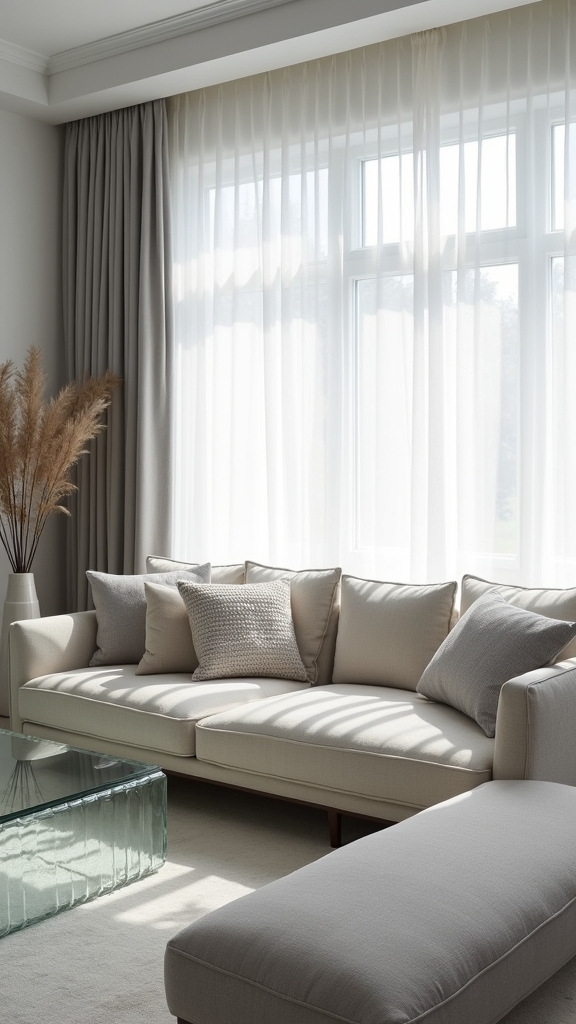
Sheer grey curtains introduce an ethereal light filtration, balancing privacy with a luminous ambiance that complements the tonal subtleties of grey walls.
Their airy translucence injects understated texture and gentle movement, breaking up visual monotony without detracting from a modern, layered scheme.
This approach aligns with current design trends favoring soft materiality and adaptable, seasonally responsive decor.
Enhance Light and Privacy
Although maximizing both illumination and intimacy is a common challenge in contemporary interiors, integrating sheer grey curtains offers a sophisticated solution for living rooms with grey walls.
The nuanced translucency of these drapes expertly filters natural light, balancing privacy with a soft and inviting atmosphere. Designers favor sheer grey curtains for their ability to enhance the overall aesthetic and adapt to evolving interior trends.
Key benefits include:
- Diffusion of sunlight, reducing glare and fostering a tranquil mood
- Seamless complement to varying shades of grey walls for cohesive styling
- Creation of an illusion of height when installed from ceiling to floor
- Versatility in light control when layered with heavier drapery for seasonal flexibility
- Maintenance of privacy without sacrificing the desired luminosity within the living space
This approach exemplifies refined living room curation.
Subtle Texture and Movement
A whisper of translucent grey fabric introduces an ethereal softness to living rooms defined by grey walls, mitigating the starkness often associated with monochromatic palettes. Expert designers emphasize the role of sheer grey curtains in infusing subtle texture, their lightweight weave filtering daylight while sustaining an airy atmosphere. This nuanced layering effect not only complements the grey walls but also fosters a calming vibe integral to serene interiors. The interplay of movement—curtains swaying gently in ambient air—adds dynamic tranquility, a detail increasingly favored in modern trend circles.
| Element | Effect on Space |
|---|---|
| Sheer grey curtains | Softens starkness |
| Subtle texture | Enhances visual depth |
| Layering with drapes | Adds dimension |
| Airy atmosphere | Promotes tranquility |
| Gentle movement | Uplifts calming vibe |
Combine Grey With Soft Pastel Tones

Many contemporary interiors showcase the sophisticated interplay between grey walls and soft pastel tones, such as blush pink, mint green, or pale blue.
This harmonious pairing is favored for its ability to cultivate a calm atmosphere while remaining visually compelling. The subtle contrast of soft pastel tones against grey walls enhances both serenity and style, creating spaces that feel both modern and inviting.
Soft pastels paired with grey walls foster tranquility and style, making interiors feel refreshingly modern yet welcoming.
Designers often leverage this color synergy to brighten darker greys and introduce warmth without overpowering the scheme. Incorporating bold colors as accents can further enhance the visual appeal of the space by adding focal points that complement the serene pastel tones.
To augment visual interest and achieve a balanced look, consider:
- Introducing pastel accent pieces like cushions or vases
- Applying the 60-30-10 rule for proportionate color use
- Layering textures in pastel hues—think rugs or throws
- Selecting artwork with subtle pastel details
- Varying fabric finishes for depth and sophistication
Create a Focal Point With Statement Art

Transforming a grey living room wall into a striking focal point starts with the strategic placement of statement art. Large-scale artworks, especially those featuring vibrant colors or bold designs, create a focal point by introducing visual contrast against a subtle grey backdrop. This contrast not only commands attention but also adds dimension and sophistication to the space. For those seeking a more dynamic approach, a gallery wall composed of smaller art pieces delivers layered interest and maintains a cohesive look when curated thoughtfully. Selecting art that harmonizes with the room’s existing palette enhances the serene mood, ensuring the decor remains unified. Elevating statement art with distinctive frames or mounts adds architectural detail, reinforcing the calming ambiance that grey walls naturally provide in contemporary living rooms. Integrating bold geometric patterns can further enhance the visual interest, combining modern design elements with the tranquility of a grey palette.
Introduce Textured Rugs and Throws

When layered thoughtfully, textured rugs and throws in a spectrum of greys introduce tactile richness and visual depth to a living room, elevating the space beyond monochromatic minimalism.
The interplay of various textures—shaggy, knitted, or woven—creates dynamic visual interest and enhances a cozy atmosphere essential for a calming mood.
Mixing shaggy, knitted, and woven textures brings inviting warmth and visual intrigue to any serene living space.
Expertly chosen shades of grey in these textiles prevent the room from feeling cold or sterile, instead fostering warmth and sophistication.
The following strategies refine the approach:
- Select textured rugs with subtle patterns to break up expanses of grey.
- Layer throws in diverse fabrics, such as wool and faux fur, for tactile appeal.
- Opt for varying shades of grey to add dimensionality.
- Combine smooth and nubby textures for sensory engagement.
- Refresh textiles seasonally to maintain a dynamic, inviting ambiance.
Mix Grey With Black for Modern Contrast

Building on the tactile dimension introduced by layered textiles, incorporating black accents alongside grey walls amplifies modern contrast and visual structure within the living room.
This design approach leverages the sleek interplay between pale grey surfaces and defined black details, such as picture frames, lighting fixtures, or streamlined furniture, to craft a sophisticated, high-contrast environment.
Black elements act as visual anchors, drawing attention to architectural features or curated décor, while simultaneously intensifying the perceived depth of the grey palette.
To maintain a soothing, inviting atmosphere, designers recommend balancing the boldness of black with lighter shades of grey in the background.
This guarantees the modern aesthetic remains calm and not overpowering, exemplifying a trend-forward yet timeless approach to contemporary living room composition.
Frequently Asked Questions
What Paint Finish Works Best for Grey Living Room Walls?
Selecting a paint finish for grey living room walls depends on desired aesthetics. Matte finish and chalk paint offer a sophisticated, modern look; eggshell luster and satin sheen provide subtle reflection, while semi gloss and textured finishes enhance visual interest.
How Do I Prevent a Grey Living Room From Feeling Too Cold?
To counteract a grey living room’s potential chill, designers recommend integrating warm accents, cozy textiles, layered lighting, and natural textures. Additionally, vibrant artwork and indoor plants inject color and liveliness, balancing contemporary trends with inviting, visual warmth.
Are Grey Walls Suitable for Small Living Rooms?
Grey walls can enhance a small space when paired with light color accents and strategic furniture arrangement tips. Incorporating decorative wall art, cozy textiles, and optimizing natural lighting tricks are trending small space solutions for creating visual depth and warmth.
What Color Ceiling Pairs Best With Grey Walls?
Selecting ceiling color combinations for grey walls, experts recommend soft whites for brightness, contrasting ceiling shades like navy for drama, or warm ceiling tones such as taupe. Textured ceiling options and integrated ceiling lighting effects enhance contemporary ceiling design ideas.
How Can I Update Grey Walls Without Repainting?
To refresh grey walls without repainting, experts recommend emphasizing wall art, installing decorative mirrors for spatial enhancement, layering textured fabrics, adding greenery accents, selecting trend-forward furniture choices, and experimenting with contemporary lighting options to create dynamic visual interest.
Conclusion
Expertly layered grey walls cultivate a serene, on-trend living room aesthetic, especially when harmonized with plush textiles, tactile accents, and curated lighting. Earthy hues, verdant greenery, and soft pastels counterbalance cool undertones, while bold artwork and modern black contrasts provide visual intrigue. Textured rugs and throws further enhance depth and comfort. Together, these strategies exemplify how expertly orchestrated grey palettes can transform a living space into a calming, design-forward sanctuary reflective of contemporary style sensibilities.

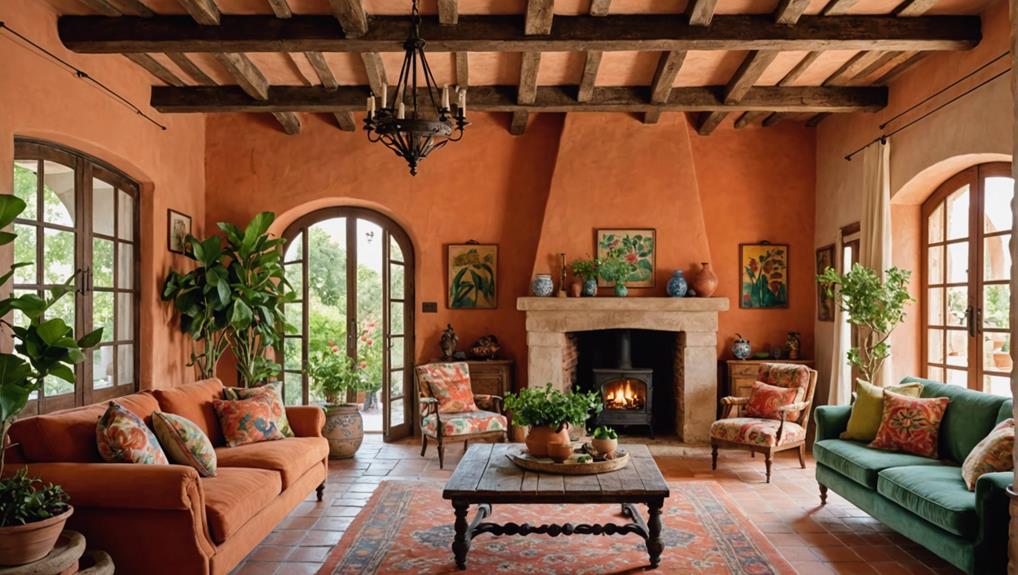
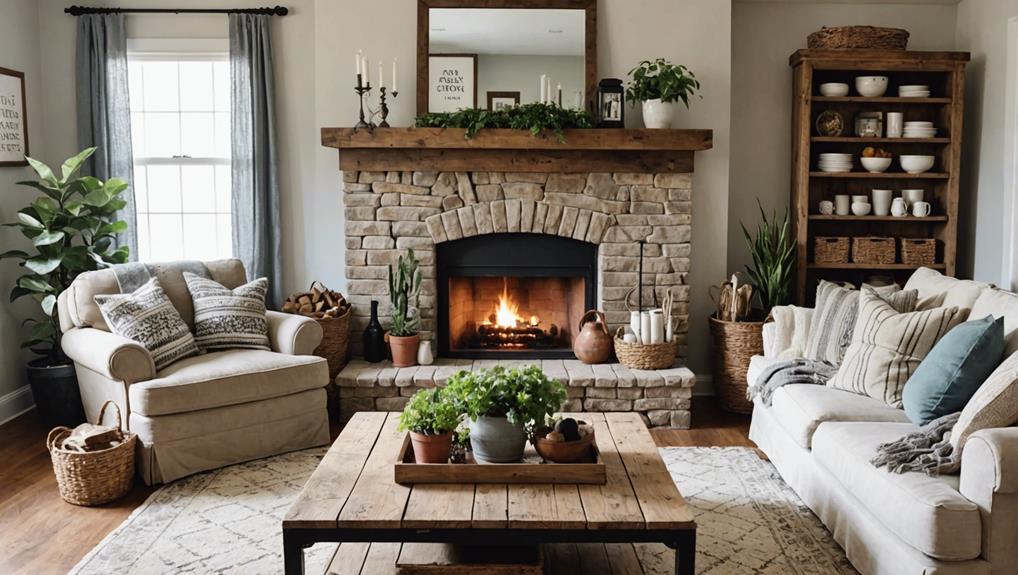
Leave a Reply